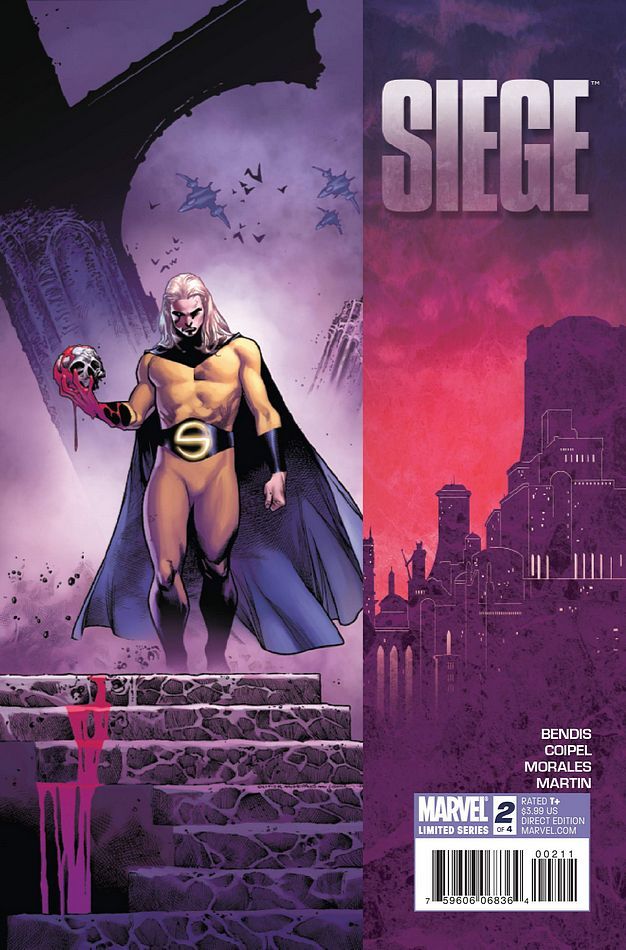Marvel's Siege #2 sold 108,429 copies in February, according to ICv2.com's latest sales estimates. Remarkably, that's only 55 copies fewer than the first issue sold in January.
This means one of two things: Either this is the most amazingly rock-solid issue-to-issue performance of an event comic ever or, more likely, as chartwatcher Marc-Oliver Frisch points out, Diamond knocked 20 percent of Siege #1's sales off its January chart to account for returnability. Either way, it seems the earlier hue and cry that Siege is some kind of flop need to be significantly dialed down.
Look, I have no idea what Marvel's internal sales expectations for Siege were or are. I know that the "seven years in the making" hype creates the sense that this was supposed to be the blockbuster to end all blockbusters, and thus sales comfortably beneath those of a late-run Blackest Night issue give the impression of failure. But at the same time, Siege is way shorter than any of the other events Marvel has done in recent years, suggesting the company and creators had a different view of its structure and goal than, say, Secret Invasion. They also started promoting its follow-up, the line-wide "Heroic Age," more or less concurrently with Siege itself, and in a way that pretty much assured readers of the outcome of the series -- in other words, Siege has been treated as much as a means to the end of "The Heroic Age" as an end in itself. All in all, it comes across as a very different beast than Blackest Night does across town.
Meanwhile, Siege isn't the only title with some mysterious sales-chart goings-on going on. Blackest Night #7's 130,613 copies appears at first glance to represent an amazing 30-percent increase over Issue 6's first-month sales of 100,651, and that's pretty much how ICv2 reported it. But keep in mind Issue 6 was first sold during Diamond's "skip week" between Christmas and New Year's, meaning it actually shipped the week before it went on sale; retailers who failed to sign an embargo agreement received their copies the first week of January instead, and thus 35,344 copies' worth of sales ended up showing up on the January charts rather than the December charts. Thus, Issue 7's performance represents a drop of around 5,000 copies, not an increase of 30,000. Blackest Night is still the hottest thing in monthly comics these days by a long shot, but it's not adding a third of its readership with its penultimate issue, any more than it lost a third of its readership in December.
Two caveats are necessary here. The first is that in evaluating the two series' relative performance, I'm not making any qualitative judgments, pro or con, about their writing, their art, their core ideas, the way they stem from and lead into other storylines, and so on. Introduce that many variables into the equation and you're talking about something very different than the simple notion of whether these books are performing to their publishers' expectations. (For what it's worth, I've got shelves full of books by both Brian Michael Bendis and Geoff Johns, and read a roughly equal number of comics from both publishers, and know and like and have collegial working relationships with tons of folks at both companies. I'm Switzerland, baby.)
The second caveat -- as is probably evident from the way tens of thousands of sales for both books have mysterious disappeared and reappeared from the charts at one time or another -- is that the sales charts for comics are astonishingly opaque. I'm not Marc-Oliver Frisch or Paul O'Brien or John Jackson Miller or Milton Griepp, so I'm probably about to get some of this wrong. But as far as I know, we're really looking at sales from the publishers to the retailers, not the retailers to the customers, first of all. And we're extrapolating specific sales from that weird Diamond index system, not actually being told by Diamond how many copies sold. And we're only looking at the direct market, not all the other sales avenues available to publishers. And there are tons of hinky variables, like that skip week or returnability, that can skew the numbers in a way that isn't always immediately apparent or disclosed. And you can't swing a dead cat without hitting a creator who will tell you just how wrong these estimated sales numbers that everyone bats around each month really are. And ultimately this kind of situation is much better for determining overall sales trends (given that all the built-in errors are, at least, probably consistent over time), not confidently calculating the month-to-month fates of individual titles. In short, in the absence of rock-solid, specific, total sales numbers backed up by a transparent methodology and provided by either Diamond or the publishers themselves, there's a degree to which we're all the blind men feeling the elephant. It's just that in this case, the Siege elephant feels healthier than some doomsayers believed.


